The World’s First Live Streamed Augmented Reality Music Experience: Watch a Gig from the Front Row, Anywhere in the World
How We Used 5G to Deliver a Real Time AR Music Experience in a Different Location
What if you could watch a gig from anywhere in the world and still be right there in the front row? As part of the CORE project, we developed the world’s first live streamed Augmented Reality concert experience. This brings bands to life in real time, wherever you are. With cutting-edge 5G tech, immersive visuals and physical sensations through haptic vests, we’ve reimagined how live music can be experienced.
Meet the Minds Behind the Music Tech: The Client Powering This Live Streamed Augmented Reality Music Experience
Gooii worked alongside a consortium of partners to develop emerging technologies that are designed to test and improve mobile capacity in busy areas of the UK, or ‘High Demand Density’ locations. These included AWTG, Benetel, Ontix, Wolfram, University of Surrey and University of Cambridge. We were also thrilled to be partnered with the historic Cambridge Corn Exchange venue.
Read more about the new 5G Open Ran network.
Turning the Vision into Augmented Reality: The Brief That Sparked a New Way to Experience a Live Gig
We were asked to design an experience that would celebrate 150 years of the Cambridge Corn Exchange using Augmented Reality. For this, we conceived a live stream experience in AR, broadcasting bands from one location to another.
Key Deliverables that Brought the Live Streamed Augmented Reality Music Experience to Life
Using the 5G network, we were able to:
- Stream 8K 3D video live from the stage at the Corn Exchange to a second location
- Stream live audio direct from the mixing desk
- Deliver the feed over 5G in under 1.5 seconds from the camera to the receiving location
- Deliver the experience to multiple users
- Maintain audio and video sync with no lag between headsets.
Live Streamed Augmented Reality Concert: How We Developed The Technology
Nexus Studios Sheffield designed a large bespoke green screen for the project. This was constructed for use on the Cambridge Corn Exchange stage. We then used specially adapted 3D cameras to capture the live bands.
This followed an extensive R&D stage, where we worked with AI systems to separate performers from the background. We then removed the background on-the-fly, using streaming technologies developed in-house. This was achieved in combination with some excellent third party services.

This allowed us to place a live hologram of the band into a receiving location in front of the audience.
To facilitate this, we developed live streaming deformation software to unpack the streamed 3D image. Using 8K spatial video, we were able to live stream the footage to Meta Quest and Apple Vision Pro headsets across the 5G Open Ran network.
Public Trials
We commissioned two bands – folk duo Smith & Brewer and rock band Hungry – to play at the Corn Exchange during a day of public trials.
Using the 5G network, the bands were live streamed in AR to another location, where participants put on headsets, headphones and haptic vests. The band then played in front of the audience in full 3D AR placed in the real world.
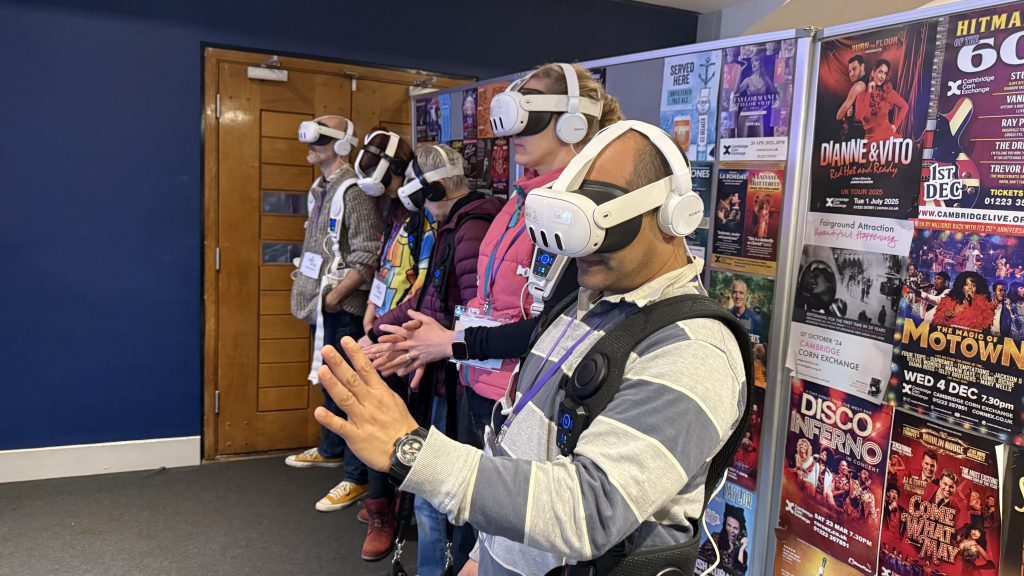
Front Row and On Stage
This created a unique and immersive viewing experience for live music fans. It also gave them a front row view of the live performance. It felt as though you were standing in front of the band and that the artists were performing to you. Compared to watching on TV or even streaming in VR, this replicates a real gig experience. This achieved creating a real emotional connection between the band and viewer.
With our live AR experience, you can see the musicians up close, much closer than if you were at a real gig. It enables you to see little details happening live, such as finger picking and chord changes.
One participant said: “The technology was really impressive. It could certainly replace watching live music on TV, which never really seems to engage. It added an extra dimension – literally – and I felt in the room with the performers.”
Client Testimonials
Here’s some of the feedback we got from participants of the trial:
- “The live stream was clear and uninterrupted and the band was excellent!”
- “Sound was really excellent. Better than the live experience perhaps musically. I felt totally present and engaged.”
- “It felt really close to “being there”.”
- “The immersive clarity and ability to interact with the real world was excellent… Impressive that such an experience was live streamed.”
- “Where this industry and the world is heading.”
- “A profound experience. I found myself smiling and tapping as if the musicians were in the room. Being able to watch their finger picking and chord changes was a huge improvement on the real thing.”
- “Looked like it was real and in the room with you.”
- “A great way for people who have trouble attending shows to get to see bands live.”
Flying Drumsticks – A Real 3D Experience
The beauty of using 3D meant we could capture the dynamic nature of a live music set. Imagine guitars being flung towards you as the lead plays their famous riff, or a drum stick being thrown into the crowd. This really enhances the interactive and immersive experience. It’s enough to make you physically respond, which many participants did.
Another participant said: “That was really good fun, a unique experience. They’re right in front of you, like you’re being serenaded. It’s interactive – you lean back at first because you think things are coming at you. Really cool! One of the most unique experiences I’ve had watching music.”
Physical Sensations: Feeling the Music
By donning a haptic vest, you physically feel the vibrations of the bass and drums. This replicates the unmistakable feeling of standing in a crowd watching a performance and physically feeling the music.

“You get the visual, the sound and the body experience. To feel that and take it all in and experience it… It feels like you’re in the front row.”
Opportunities for Using the Technology
The success of this live streamed Augmented Reality music experience opens the door to a wide range of exciting possibilities across the music industry, and beyond. For artists, it means the ability to perform in multiple locations simultaneously, reaching global audiences without the need for travel. For venues, it offers a new revenue stream by selling tickets to sold-out gigs, or exclusive behind-the-scenes performances.
Cambridge band Smith & Brewer told us how they found live streaming a gig in AR. “It’s incredible being in two different places at once! Particularly if you have an audience spread around the world and it’s impractical to go and tour Australia.”
AR live streaming also presents game-changing opportunities in accessibility. Fans who may not be able to attend live events due to physical, geographical or financial barriers can still enjoy an immersive, high-quality gig experience. Live sign language interpreters could also be added in Augmented Reality whilst a band perform on stage.
Educational institutions and music academies could use the technology for live masterclasses or virtual rehearsals, giving students a front row seat to watch technique in action, right down to finger placement and stage presence.
Beyond music, this technology can be adapted for:
- Theatre
- Dance
- Sport
- Business conferences
- Lectures
- Documentaries
- Training
- In care homes and hospitals
- Helping deaf and visually impaired people.
Good’s live AR streaming technology offers real-time, spatially-aware, high-quality streams that create presence and emotional connection. As 5G and AR capabilities continue to grow, so too does the potential to redefine how we experience live events. Making them more inclusive, more immersive and more unforgettable than ever before.
The Future of Live Music Experiences
This live streamed Augmented Reality music experience has shown just how far technology can take us in creating more accessible and engaging ways to enjoy live music. With 5G and AR, audiences can now connect with performances in real time, wherever they are.
Here at Gooii we love live music. Our AR experiences aren’t designed to replace live entertainment but to complement it. For many bands, touring the world is no longer affordable and is tied up with red tape. Artists are already streaming live gigs from venues, basements and garages. With our AR technology we can take this to the next level, so you aren’t just watching a live stream, the band is playing in the room with you. Be it at a ticketed venue, or in your own home. Gigs can also be recorded and sold again, earning repeat revenue.
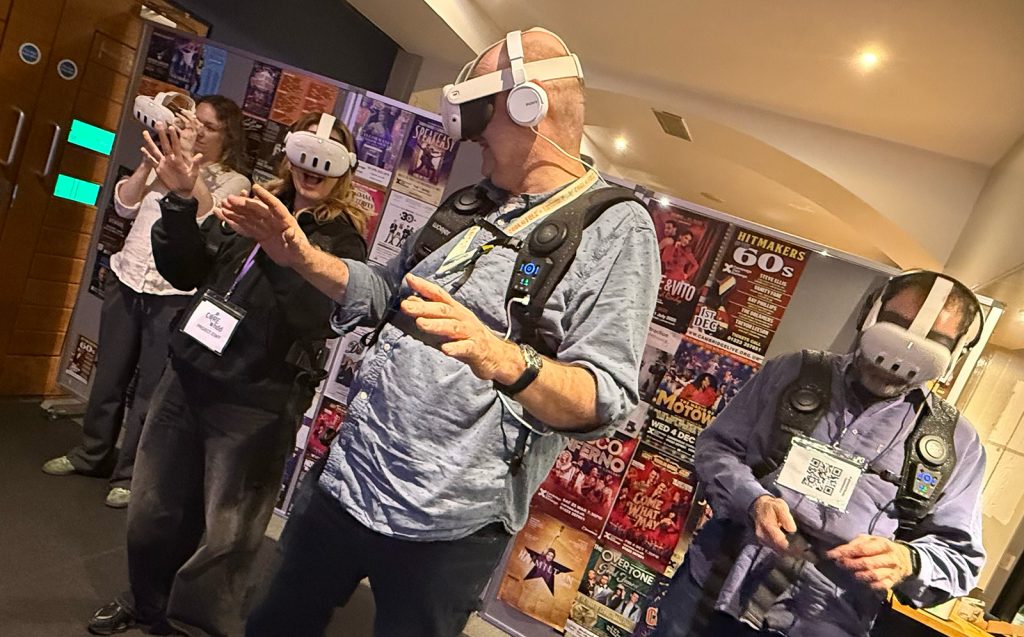
An Enriching Experience
This has been an incredibly enriching and rewarding experience for Gooii. The trials provided a rare opportunity to gain insight, feedback and ideas that will further improve live AR streaming. It was also immensely gratifying to see the joy and sense of wonder we brought to people. Due to a solid and robust network, there were also no technical issues which allowed us to deliver a fully commercial experience.
Gooii are proud to have delivered a step forward for live events, whilst opening up new creative opportunities for artists, venues and fans alike.
How Augmented Reality is Transforming Live Events and Immersive Experiences: AR Car Show
What if your audience could step back in time, walk among vintage vehicles, ride in a sports car and even climb inside a DeLorean? That’s the power of Augmented Reality (AR).
Creating the World’s First Augmented Reality Car Show for Live Audiences
As part of the CORE project, we set out to explore how Augmented Reality experiences can reshape public engagement, storytelling and entertainment. With a brand new 5G Open RAN network and a historic venue brimming with cultural legacy, we pushed the boundaries of immersive technology. Our goal? To turn history into a living, breathing experience. And prove AR is a powerful tool for bringing communities together and reimagining what’s possible in a live event space.
In this blog, we will:
- Explore how immersive AR experiences can elevate live events
- Take a deep dive into our groundbreaking work on the world’s first AR car show
- Listen to what the trialists thought of the experience
- Explore how AR can elevate any event or industry.
Whether you’re an event planner, brand strategist or creative technologist, discover how this technology is reshaping storytelling, engagement and the future of live experiences.
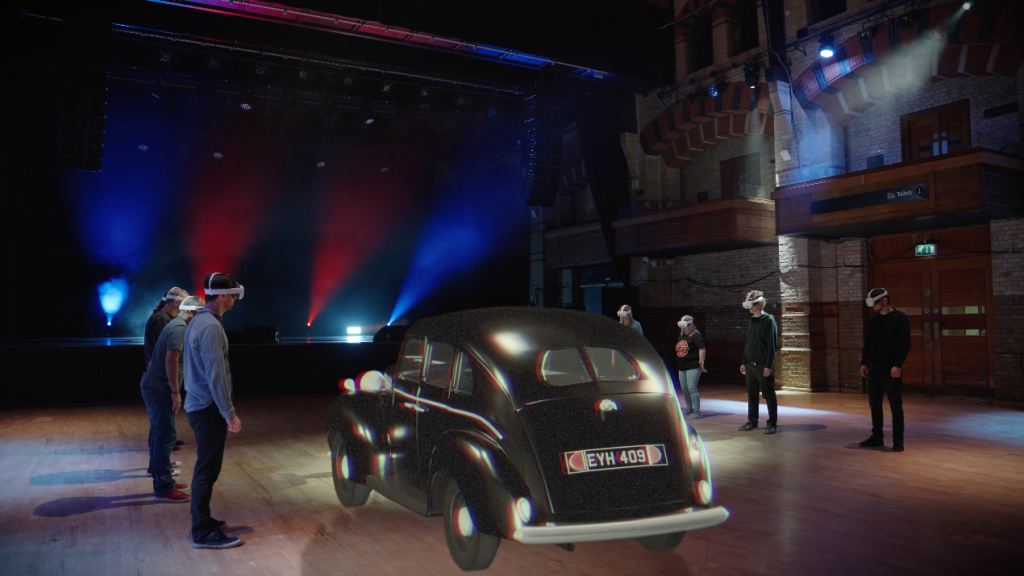
The Vision and Client: Turning History Into an Immersive AR Journey
Gooii’s Augmented Reality Car Show was part of the CORE project, funded through the UK’s £88 million investment in 5G Open RAN technologies. Led by Connecting Cambridgeshire, the initiative brought together partners to test the 5G network in high-demand areas.
Gooii is proud to be working alongside a range of partners on the CORE project including:
- Connecting Cambridgeshire
- Department for Science, Innovation & Technology
- AWTG
- Benetel
- Ontix
- Wolfram
- University of Surrey
- University of Cambridge.
Our role focused on developing community-focused AR experiences at the Cambridge Corn Exchange to support local tourism.
Read more about the new 5G Open Ran network.
The Brief: Bring a Century of Vehicle Culture Back to Life in AR
Utilising the new network, the brief was to create an Augmented Reality experience that celebrated the Corn Exchange’s 150 year history. Shining a light on the historic car shows that used to take place in the venue in the early twentieth century.
What We Delivered: From Penny Farthings to Flying DeLoreans
The result was a virtual re-enactment of these shows, including a variety of different vehicles that all had a link to Cambridge.
These included the Penny Farthing, Peugeot Phaeton, the Austin Cambridge, the Sinclair C5, e-scooters and pedal bikes. We also featured a DeLorean car as seen in the film Back To The Future. This was thanks to links with Cambridge Audio, who are making the audio equipment for the new DeLorean range of cars.
Testing the Tech: Real People, Real Reactions
In order to test the technology, we set up a public trial day at the venue. We invited members of the public to test the AR experiences we had developed in-house. For this session, participants put on AR headsets and walked around the auditorium, into which the car show was delivered.
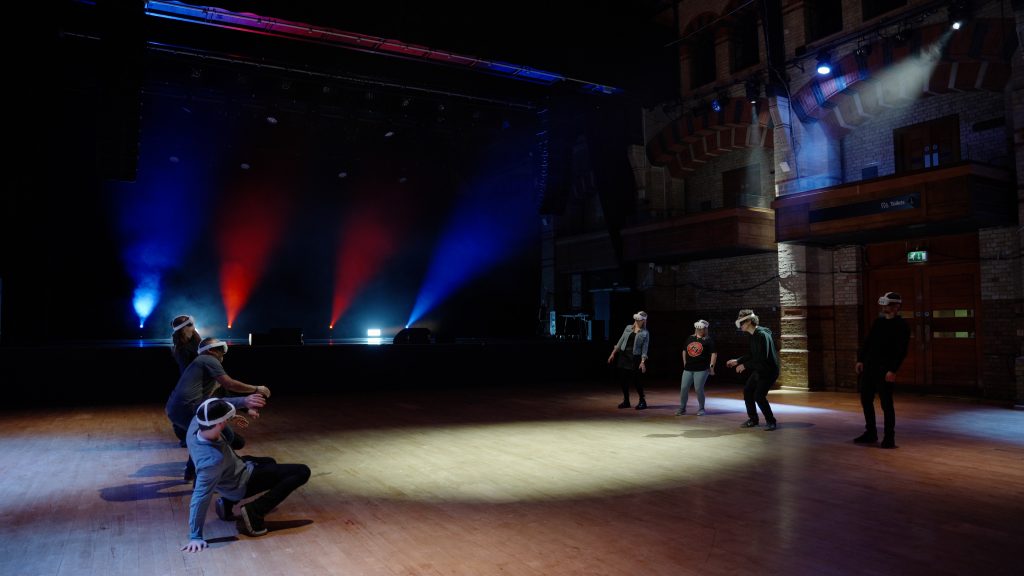
Behind the Scenes: How We Built the AR Car Show
Using detailed archive photos and footage, we 3D modelled the vehicles in our studio. Our coders then turned these fantastic models into an interactive AR experience.
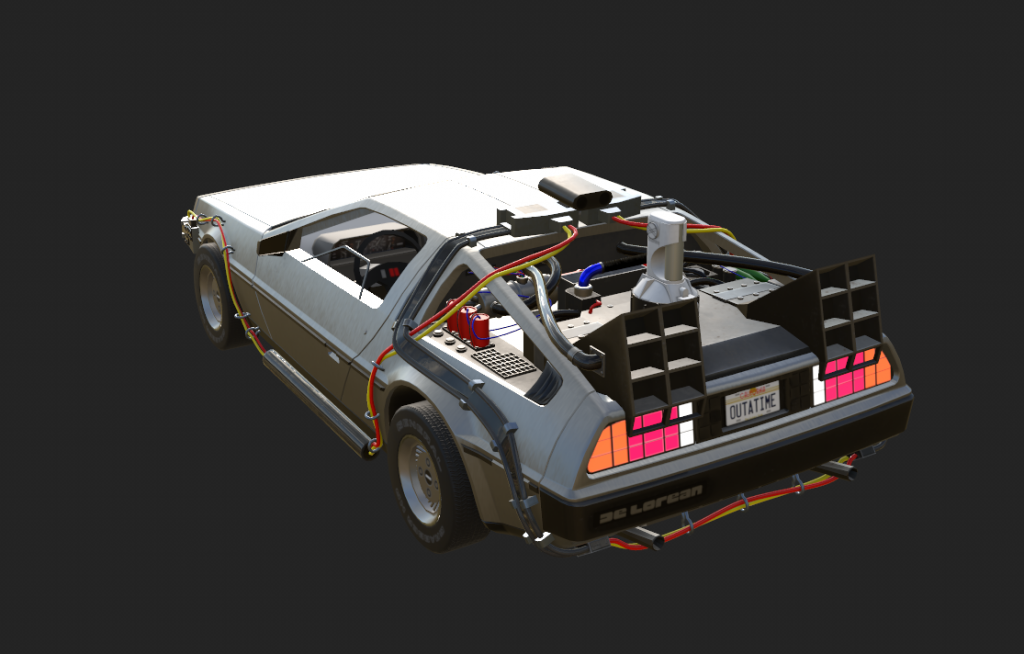
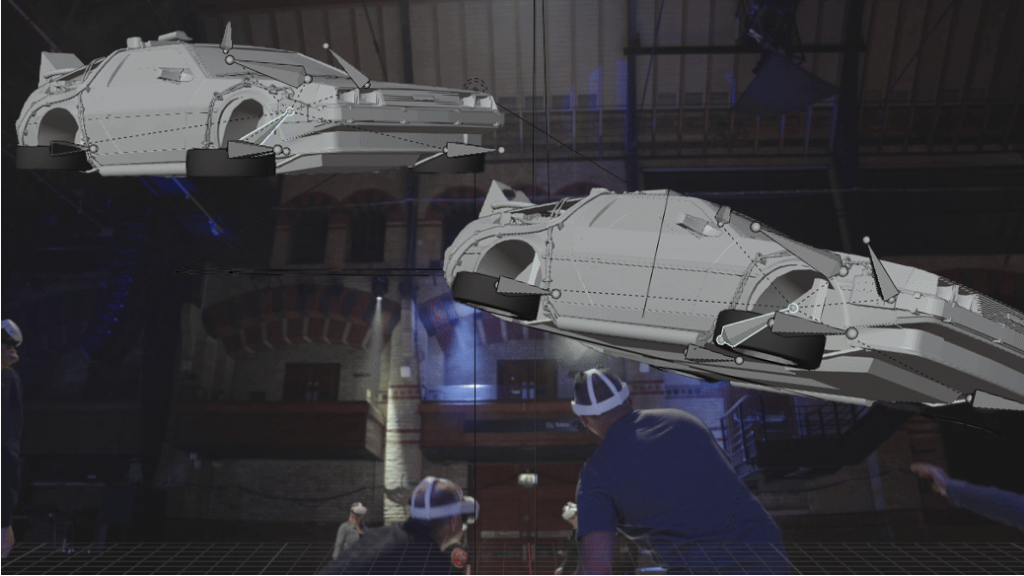
During the trials, participants gathered at the Corn Exchange and put on their AR headsets. The headsets streamed the CGI assets from an edge server, displaying them as holograms projected into the real world space.
The cars were navigated via a control panel, so everyone in the group could see the cars as they travelled through time. Participants could walk around the vehicles and explore the cars in great detail. It was even possible to get in them and experience what it was like to drive these classic machines.
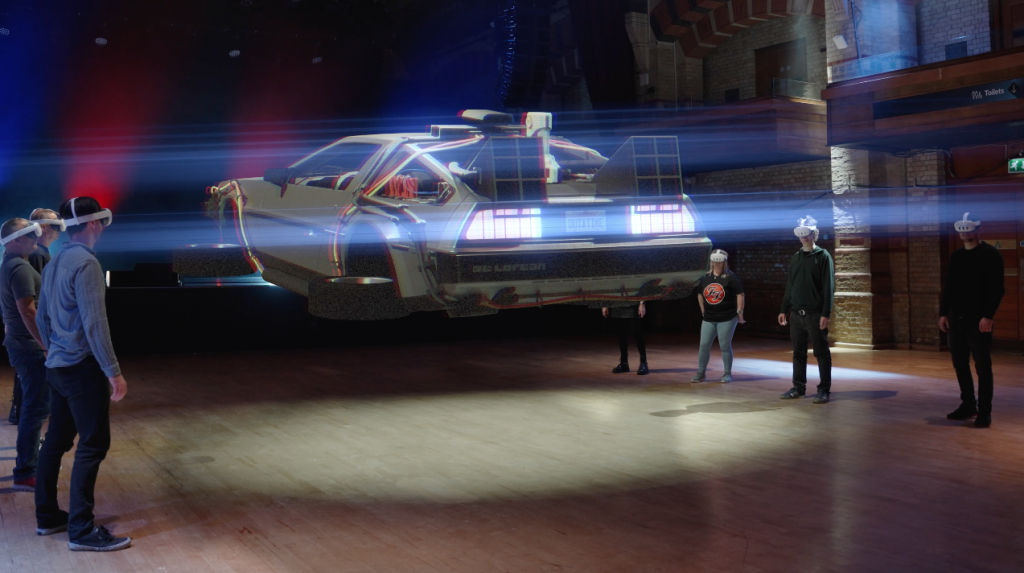
From CGI to Flying Cars: Making the Content Come Alive
We developed a series of CGI effects to enhance the experience and make the content come alive.
There was a constant roaring of engines and a thumping soundtrack for each vehicle, ranging from Queen’s ‘Bicycle Race’ for the classic Cambridge bike, to ‘Don’t You Want Me Baby’ by The Human League for the ahead-of-its-time electric Sinclair C5. We also turned the DeLorean into a flying car, swooping over the audience in a bolt of electricity to Alan Silvestri’s ‘Back to the Future’ theme.
Real Feedback: What Audiences Thought of the Experience
“Projects like this are the future, because ultimately it’s changing the way we consume media.” – John Naylor, Nexus Studio
“You can have a car show that happened here in the early 1900s recreated using 5G and AR. So it can really feel like you’re back there for one of the amazing purposes that this building took on.” – Pete Robbins, Cambridge Corn Exchange.
Here’s some of the feedback we received from trial participants:
- “The cars were mind-blowing!!!”
- “I loved that you could see what was inside the car.”
- “The experience was seamless”
- “I love the flying Delorean and the fact you can actually look inside the vehicles.”
- “You could see your environment and people you were with as well as the cars.”
- “Exceeded all expectations.”
Hands-On History: Climb Into Classic Cars with AR
We took the experience to the next level by allowing participants, not just to view the vehicles from the outside but to actually step inside them. Users could explore the interiors of each car in rich detail – from the steering wheels and dashboards, to the seating and design features unique to each era.
This added a layer of interaction that transformed the installation from a visual showcase into a fully immersive experience. This gave users a deeper, more personal connection to the vehicles and the history they represent. It wasn’t just about seeing, it was about feeling and believing these classic vehicles were truly there.
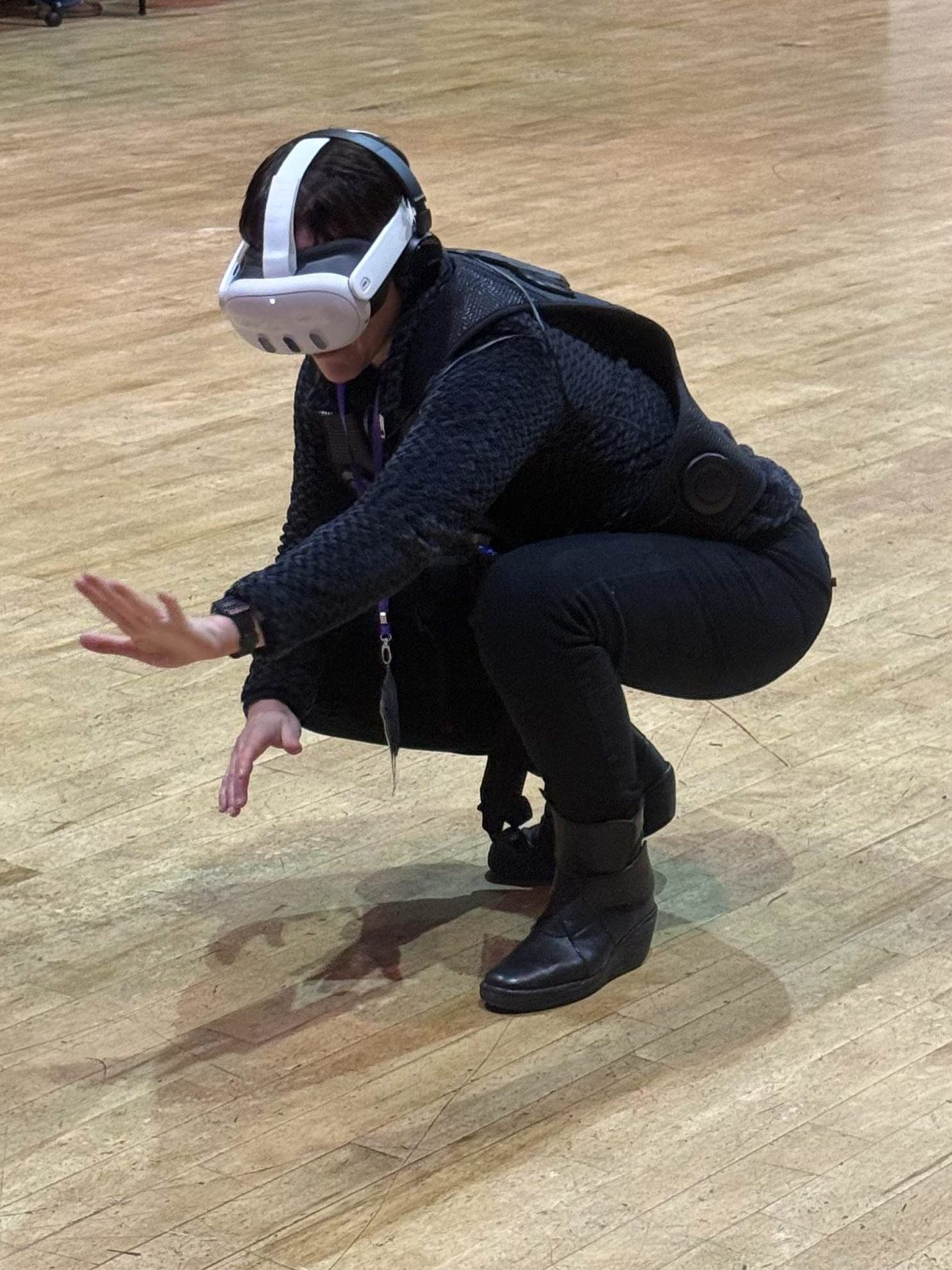
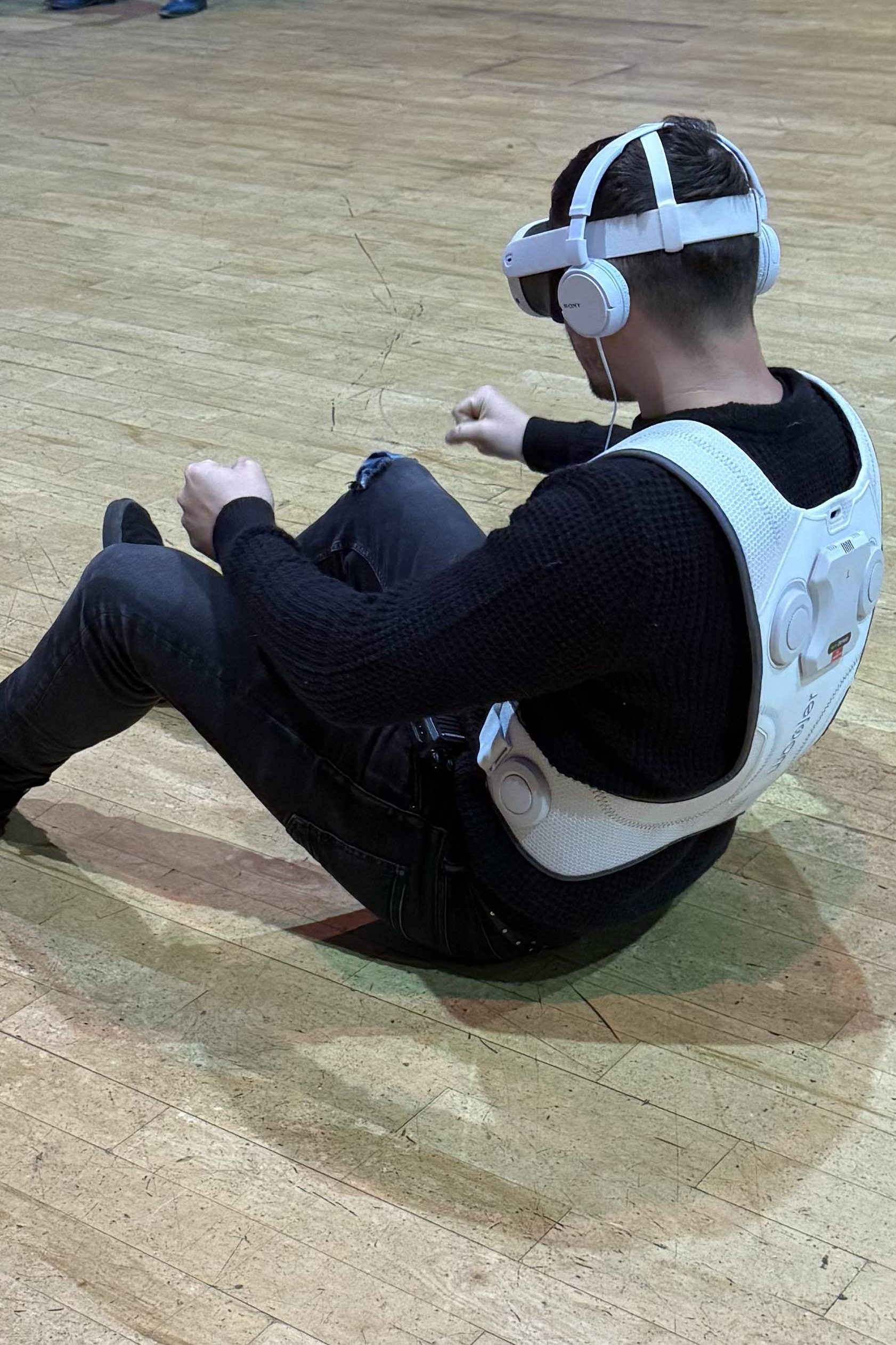
Beyond Car Shows: How AR Can Elevate Any Event or Industry
The possibilities for Augmented Reality experiences in events and beyond are limitless.
Transforming Corporate Events and Brand Experiences
For the corporate world, AR is a game-changer for engagement. Product launches can become multi-sensory, training sessions can turn into interactive simulations. Keynote presentations can come alive with responsive, 3D visual content. Businesses can better capture attention, improve knowledge retention and make messaging more memorable. Movie companies can create
Virtual Exhibits and Smart Prototyping
Across museums, exhibitions and manufacturing, AR can bring ideas to life without the logistical or financial constraints of physical builds. Entire exhibits can be created virtually and industrial teams can model and test products before making real-world investments.
A New Era for Entertainment
Whether it’s a theme park, cinema or conference stage, AR has the potential to transform the way we create, educate and entertain – making every experience more immersive, impactful and unforgettable.
Reimagining Live Performances
In the performing arts, AR creates endless new possibilities. Imagine a theatre production, opera or immersive show where digital set pieces and props appear and disappear in real-time, dynamically enhancing the narrative and drawing audiences deeper into the story.
Immersive Storytelling & Education
AR is rapidly emerging as a powerful tool for learning and storytelling. Experiences like the AR Car Show could be expanded into immersive time-travel journeys – enabling participants to watch objects evolve through history, or interact with virtual figures like designers, racers or cultural icons who appear alongside artefacts to share their stories.
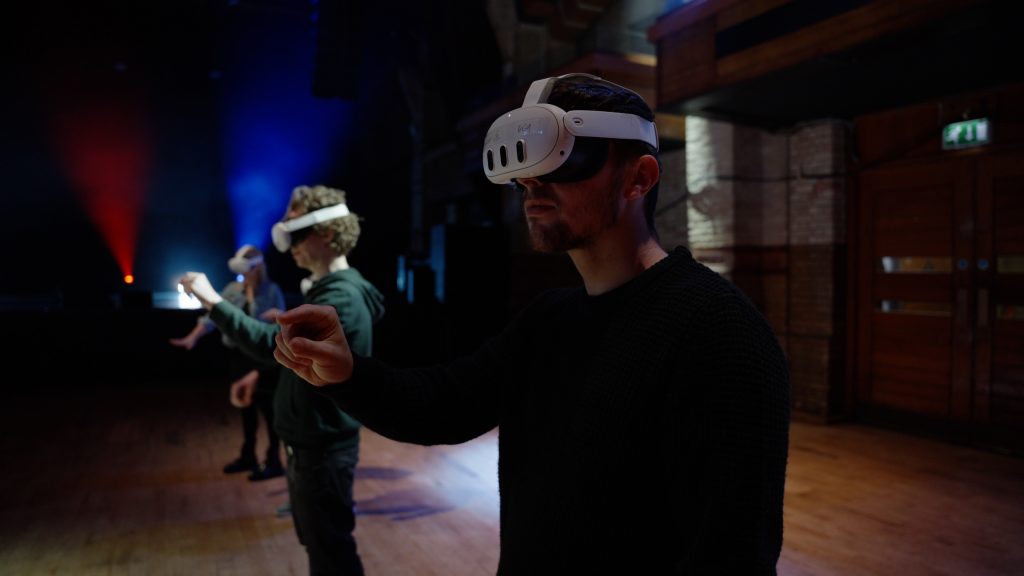
A Glimpse into the Future of Live Events
The AR Car Show at the Cambridge Corn Exchange was more than just a showcase of classic vehicles. It was a proof of what Augmented Reality experiences for events can truly achieve. By blending digital innovation with real-world spaces, we created something memorable, meaningful and accessible to all. It showed us that AR can breathe new life into history, deepen audience engagement and transform static venues into interactive storytelling platforms.
As we look ahead, the possibilities for AR in events, education, business and beyond are limitless. From immersive exhibitions and live performances to virtual training environments and brand activations, this technology is ready to take centre stage.
This is just the beginning. If you’re ready to explore how AR can elevate your next event or project, we can bring your vision to life.
Step Into the Future of Entertainment with Gooii’s Groundbreaking Augmented Reality Concerts
Imagine standing in front of a real stage, then suddenly, a hologram of David Bowie appears, stars fill the room and the crowd around you dances as he launches into ‘Star Man’.
No, it’s not sci-fi. It’s the world’s first Augmented Reality concert, and we just made it happen. We’ve turned a historic venue into a live portal for jaw-dropping, 3D performances, blending cutting-edge tech, holograms and zero-latency connectivity to create an immersive shared AR concert experience. Curious how we pulled it off? Let’s dive in.
Creating The World’s First Holographic 3D Concert
Gooii has successfully developed the technology for audiences to project an Augmented Reality concert into a real-world venue.
As part of the CORE project, we’ve been developing a series of Augmented Reality experiences at Cambridge’s historic Corn Exchange to test a new 5G Open Ran network.
The result is a groundbreaking Augmented Reality concert experience, which transforms any real-world stage into a portal for immersive, holographic performances. It enables audiences to relive historic shows as if they were happening live, right in front of them.
In this article, we’re going to delve into the project and…
- Explain how we developed the technology for the Augmented Reality concert
- Look at how CGI effects made it a more immersive experience
- Explain why zero latency is so important for AR
- How we made it a shared yet personal experience
- Look at how we can use this technology in your industry
From Government Innovation to Holographic Performances: Meet the Visionary Team Behind the Augmented Reality Concert
We’re incredibly proud to be part of the government’s £88 million investment in innovative open 5G connectivity solutions across the UK.
The Cambridgeshire Open RAN Ecosystem (CORE) was one of 19 projects that benefited from the Department for Science, Innovation and Technology (DSIT) funding. The project is being led by digital connectivity programme Connecting Cambridgeshire, on behalf of Cambridgeshire County Council.
We worked alongside a consortium of partners to develop emerging technologies that are designed to test and improve mobile capacity in busy areas of the UK, or ‘High Demand Density’ locations. These included AWTG, Benetel, Ontix, Wolfram, University of Surrey and University of Cambridge. We were also thrilled to be partnered with the historic Cambridge Corn Exchange venue.

New hardware and software has been developed to test the capabilities of a super-fast Open RAN network. This was done with the aim to support the local tourism industry and test how well the network can handle large amounts of data.
Read more about HDD locations and the new 5G Open Ran network.
Gooii’s Public Trials Featured on ITV East Anglia News
Reimagining 150 Years of Music History: The Brief That Sparked a Groundbreaking Augmented Reality Concert Experience
Using the new network, the brief was to design a new experience that celebrated 150 years of the Cambridge Corn Exchange and the artists that have played there.
Key Deliverables
- We used actors to recreate classic performances in life-like 3D
- Artists were placed as holograms on the Corn Exchange stage
- CGI was added to enhance the performances
- Artists performed directly to each audience member
- Content was streamed via an edge server over a private 5G network
- The performances were delivered to the audience in perfect sync
- A management app was developed to control the experience.
Public Trials
In order to test the technology, we set up a public trial at the Corn Exchange. Members of the public were invited to test the AR experience developed in-house by Gooii.
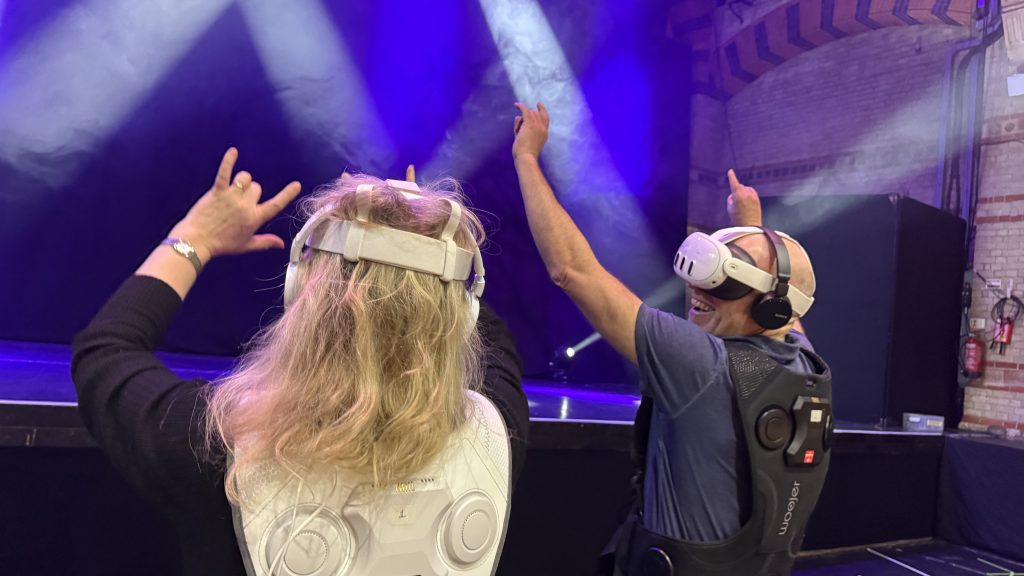
Augmented Reality Concert: How We Developed The Technology
The process for developing this technology started in our offices in Nottingham, before the production was taken to Nexus Studio in Sheffield.
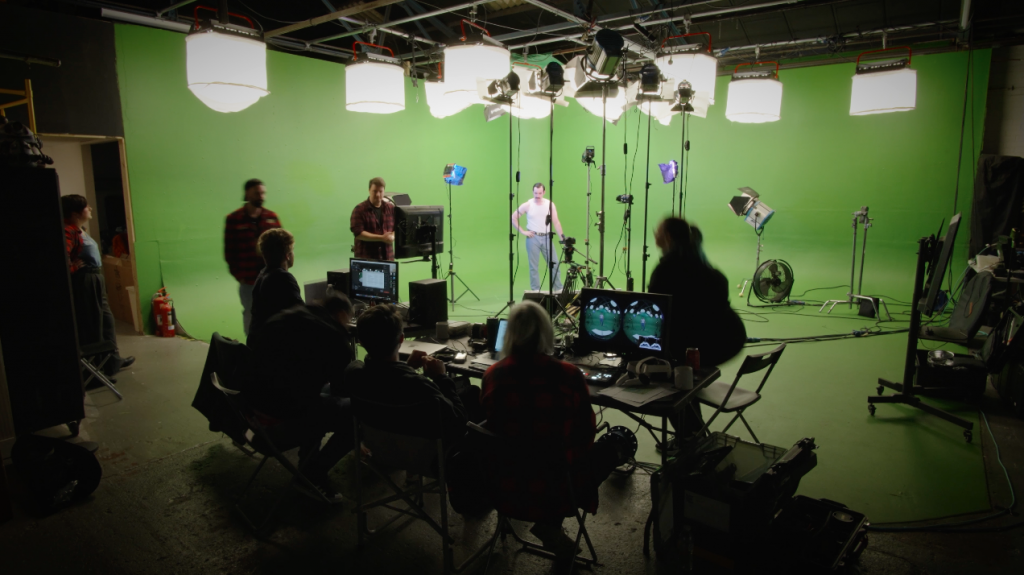
We recorded real-life artists and performers, who recreated historic shows from the Corn Exchange’s history. These included actors playing Dave Grohl, Adele, David Bowie, Diana Ross and Freddie Mercury. Working with Adam Marsden and Dan Mears from Next Step Films, we created stunning 8K 3D performances.


Our expert coders and designers then turned this into an immersive AR experience that can be viewed anywhere in the world.
To deliver the experience, we networked a series of Meta Quest and Apple Vision headsets. By connecting the devices we were able to share data, interact in real-time and synchronize the experiences. This ultimately ensured participants were all part of the same experience.

Audience members gathered in front of the stage and put on their AR headsets. The headsets then streamed the 8K 3D content as holograms on the stage in front of them.
This resulted in thrilling reenactments of events from the Corn Exchange’s history, in the exact same place they happened many years ago. Using our AR technologies we transported the audience back in time and back to the future.
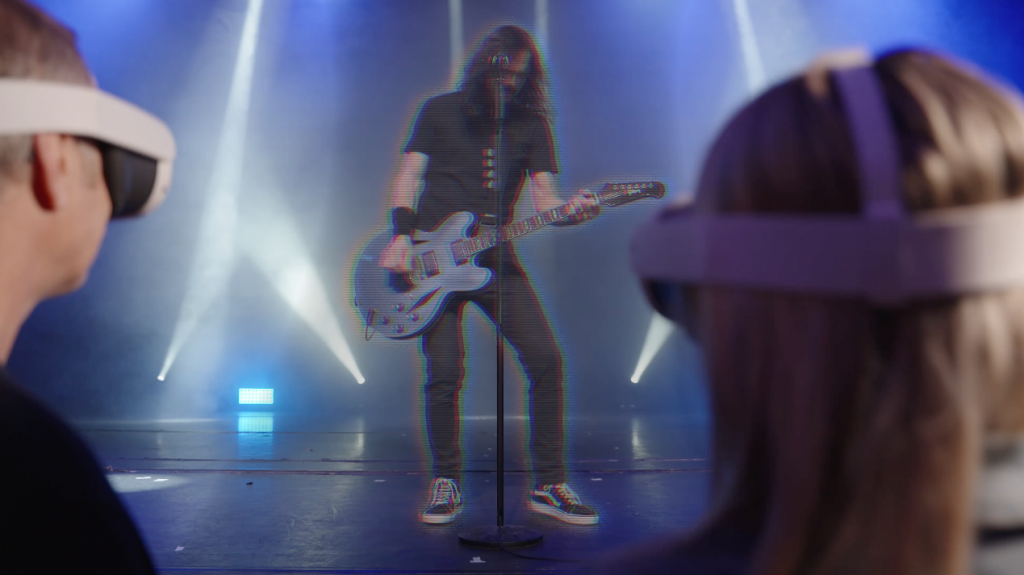
How Are These Augmented Reality Concerts Different From Virtual Reality?
The AR concert is different to the Virtual Reality gigs we’re used to seeing. VR concerts create entirely digital environments, immersing users in a fully virtual space, including the audience, stage and performers.
Gooii’s Augmented Reality technology overlays digital content onto the real world. This means participants can still see their surroundings while watching the holographic performances. In the words of John Naylor at Nexus Studio “It bridges the gap between film and the real world and allows the viewer to step into the scene.”
Our technology allows participants to gather together in front of a real stage and watch synchronized AR performances. Unlike VR concerts, where each participant is in a digital space, AR audiences are physically together in the real world.
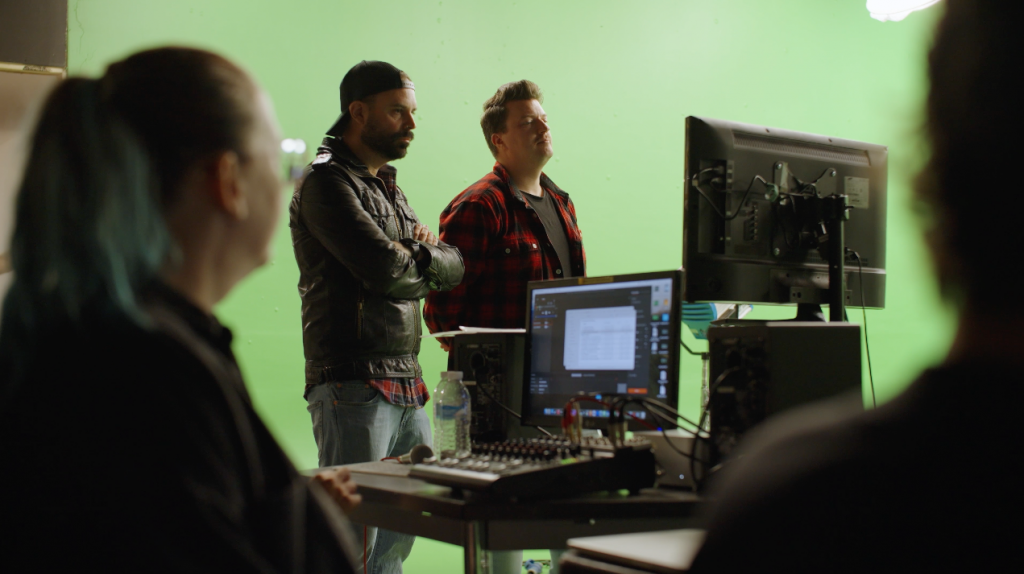
Client Testimonials
Jay Apperley of the UK Foo Fighters said “Gooii is pushing the boundaries of technology and audience viewing.”
Adam Marsden, our consultant film director, enthused: “We’re finding new and inventive ways to create a whole new canvas for people to perform on, generating a new experience for a live audience.”
John Naylor added, “Projects like this are the future. This is changing the entire way we consume media. Gooii is pushing the boundaries, it’s just mind blowing.”
The feedback from the trials was excellent. Here’s some of the comments we got from the trial participants:
- “The experience was a delight and one of a kind”
- “Exciting, new and creative experience”
- “Amazing experience. Very immersive”
- “Mind bending”
- “Unique experience, a look into the future of augmented reality in a live event environment.”
- “Unbeatable experience”
- “I will be telling people about this for weeks!”
- “Excellent insight into what’s possible augmenting live events and leveraging modern technologies.”
- “The future man!”
Using CGI to Bring Immersive Experiences into the Real World
We added CGI elements to the AR performances and replicated classic moments from live performances.This made the viewing experience even more immersive. We added aeroplanes flying over the audience during the Foo Fighters classic ‘Learn to Fly’. The room was filled with stars when David Bowie sang ‘Star Man’, and we made it rain gold glitter as Adele sang ‘Someone Like You’. These CGI effects are designed to emulate the spectacle of live shows and their music videos, elevating the experience from watching a video of a past performance to being part of an immersive, interactive show.
By blending real-life footage with dynamic digital enhancements, we recreated the energy and magic of a live concert. The result was an experience that was not only visually stunning but also deeply engaging, making audiences feel as if they had stepped into a dreamlike version of history.
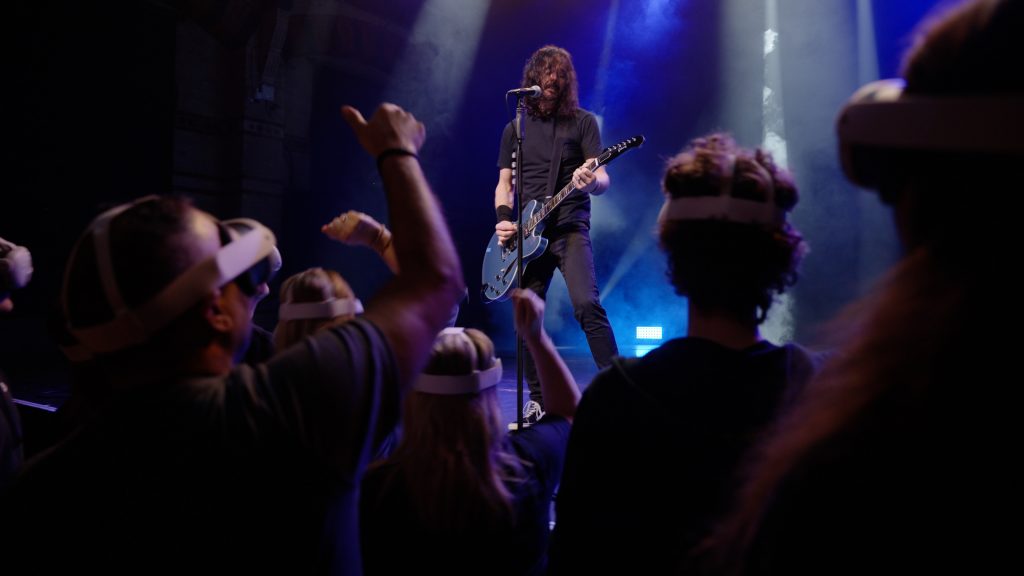
Zero Latency – Creating Shared Experiences with Augmented Reality
A cutting edge 5G network provided zero latency when delivering the content. There is no delay between the action and the reaction, which enables us to deliver an authentic AR concert experience.
It also meant that everyone in the audience was watching exactly the same thing, at exactly the same time. Participants were clapping for their favourite songs, dancing during choruses and cheering at the end of sets. It creates a truly unique, shared experience that brings people together in a way a real-life gig can.
Accessibility: Opening Up Live Experiences to Everyone
The technology also has many accessibility benefits. As Jay explained, “it allows you to feel part of a performance that you weren’t present for.” It enables you to “reach people that wouldn’t normally come and see a rock show.” This opens up many opportunities for event planners, enabling them to open the doors to a whole new audience that aren’t able to physically attend events.
People with mobility issues, or those who fear crowds, are now able to experience live music. You can also bring cultural events to people, rather than them needing to travel somewhere – think taking art exhibitions to schools or projecting a concert into a care home or hospital setting. With our concert experiences, everyone can have a front row seat.
How Event Planners Could Use This AR Technology
The success of these trials at the Cambridge Corn Exchange demonstrates just how powerful Augmented Reality can be in transforming the way we experience and interact with performance content. AR allows us to open up a world of new possibilities for audience engagement.
The opportunities for events are without limit. We can use it in corporate events and shows, sporting events, theatres, film premieres, theme parks and training.
This is just the beginning – where we take it next is limited only by imagination.
Transforming archive website development: Gooii creates new website for Scotland’s rich collection of archives
‘Your Scottish Archives’ catalogues and provides guidance on Scotland’s archives
Gooii has been working on an archive website development project for the Scottish Council on Archives to develop the Your Scottish Archives portal. It is a new online database that catalogues archival collections across Scotland.
Our development team has carefully crafted a bespoke website and search system that enables users to explore its archive collections. For this, we developed a new WordPress instance. This is a website powered by WordPress, with a custom theme built according to the needs of the client.
Why the Scottish Council of Archives approached Gooii to develop its new archive website
The Your Scottish Archives (YSA) website draws data from Jisc’s Archives Hub, which we launched in 2017. The system provides researchers with access to millions of records from 320 institutions across the UK.
Thanks to funding from the National Lottery Heritage Fund, the SCA wanted to commission a system that would make it easy for users to search through its vast collection of archives. Having seen our software and website development first hand with the Archives Hub, the SCA got in touch to discuss the possibilities of Gooii developing a system with similar functionality.
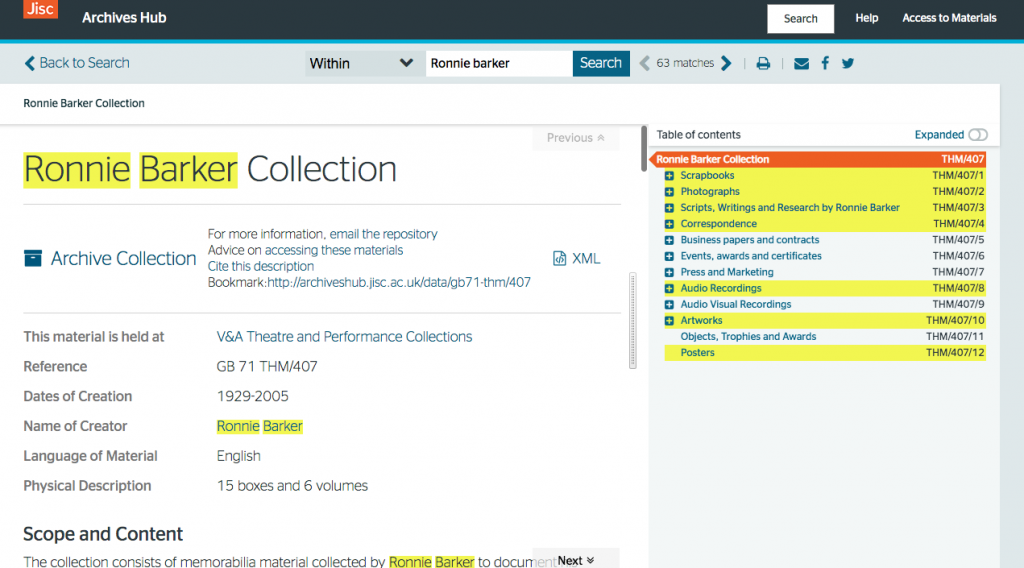
Read about our work for Jisc’s Archives Hub
Our team has intimate knowledge of the data within the Archives Hub system. We understand its hierarchical nature and have extensive experience of developing systems that are capable of holding such huge archives. We develop streamlined, intuitive User Interfaces (UI) that enable users to quickly search for specific terms and documents, whether they’re archivists, researchers or the wider public.
The brief
The new website needed to have:
- Its own branded and bespoke search interface and functionality. This would make it easy for users to search its extensive database of archives.
- The ability to publish editorial content and features.
- Information on how to contribute your own archival data.
Project partners
It’s been a pleasure to work alongside the Archives Hub and John Pelan and his team at the SCA.
We also worked with Knowledge Integration, as the YSA data is currently aggregated by them. We also worked their Collections Information Integration Middleware (CIIM), as part of the Archives Hub.
How we developed the SCA’s new archive search system
Using a CIIM to index documents
CIIM is a middleware solution – software that works between an operating system and the applications running on it. The CIIM can extract, collect and synchronise data from back-office systems and present it to users in the Elasticsearch database. This is where the data is held. We used CIIM and Elasticsearch for Jisc’s Archives Hub and knew it would work perfectly for the SCA website.
Integrating the search engine with the website
We used PHP and Clojure coding to integrate the Elasticsearch search engine with the site. We have delivered a variety of other projects using these technologies to run this database in order to build bespoke archive websites.
Integrating the Elasticsearch search application with the wider WordPress infrastructure was a new challenge for the team. We provisioned a Google Cloud-based Elasticsearch instance into which the Archives Hub system routinely publishes the data provided by archival contributors in Scotland. This serves as the database for the YSA website.
Making Scotland’s archives accessible through innovative website development
Our collaboration with the SCA on the development of Your Scottish Archives is a significant advancement in how archival collections across Scotland are accessed and explored.
By using our expertise in building large-scale, intuitive archival systems, we’ve created a powerful, user-friendly platform that meets the unique needs of the SCA.
This project not only showcases our technical capabilities in integrating complex systems like Elasticsearch and WordPress, but also highlights our commitment to preserving and promoting archival heritage.
It has been an honour to work with such dedicated partners and we look forward to seeing the impact this new platform will have on researchers and the general public alike.
Keep up to date with news on the project on our social media – LinkedIn, Facebook and Instagram.
Article by
Franz Evert
Franz is a Technical Director at Gooii and has over 20 years’ experience developing commercial and open source database driven software in many languages. Franz’s other skills include project management and client liaison and he’s passionate about high web standards and internet security.
Reliving 150 years of music: Gooii’s Augmented Reality experience set to transform Cambridge’s Corn Exchange
New Augmented Reality experience in Cambridge brings historic music performances back to life
Gooii has developed a new immersive Augmented Reality concert experience for Cambridge’s Corn Exchange, one of the UK’s most historic music venues.
The Corn Exchange has hosted thousands of concerts over its 150 year history. Using the power of AR, we’re enabling the public to relive these iconic performances.
As well as watching legendary performances from the past come to life before their very eyes, visitors can also expect vintage car time machines, an interactive wall of vortexes and a collaborative brick wall.
We’ll be using Cambridge’s new 5G Open Ran network, which is being set up to bring better connectivity to the city. Gooii’s part of the project focuses on Cambridge’s Corn Exchange, where we’re adding a visual, immersive and interactive layer to the venue and its past music performances.
What to expect from the AR experience at Cambridge’s Corn Exchange
Historic music performances
Cambridge’s new Augmented Reality experience will show artists who have passed away or are no longer touring and bring them back to life. This creates a magical performance that can technically be viewed anywhere in the world. It’ll also be a shared experience, so all audience members will see the same performer on stage.
How we developed the AR concert experience
It all started in the studio with a green screen. We filmed real-life artists who acted out classic shows from the Corn Exchange’s back catalogue. Imagine Dave Grohl performing Learn to Fly, the late Amy Winehouse singing Back to Black and David Bowie as Star Man.

And the beauty of AR is that we’re not limited to two-dimensional film. Using our 3D technology, we can further enhance the realism. We can also add CGI to do things that aren’t possible with any other live event. This enables us to do things that previously were only possible in music videos.
Watch the footage through an AR headset
Our expert coders turned the footage into an immersive experience. An AR headset is then used to view the footage, such as the Meta Quest 3 or Apple Vision. The audience puts on the headset at the Corn Exchange and a hologram of the concert appears on the stage. This transports the audience back in time. Events from history are recreated in the exact same place they happened many years ago. Sitting in a room amongst fellow fans experiencing this concert, it feels as though the artists are performing to you. It has the potential to create a real emotional connection.

It enables us to show fans what it was really like to sit in the venue and watch the performance unfold. We’re blurring the lines between technology and live events.
There’ll also be a live-streaming AR concert where we’ll broadcast bands playing at the Corn Exchange live to another location. At the second location, people will watch the gig as though it’s happening in front of them. Gooii developed these innovative bespoke technologies to make live 3D AR streaming possible.
Interactive collaborative wall
The Collaborative Wall will allow visitors to place a virtual brick to build a wall at the Corn Exchange. This is inspired by when members of the public helped build the venue. There’ll be 150 bricks to represent the venue’s 150th anniversary. Visitors will tag the brick with their name, which others can view. The completed wall will then form a mural that celebrates the venue for many years to come.
Vortex portals
Two walls of vortexes make up the portal. When a person puts their hand in a vortex they will see their hand come out of a different corresponding vortex. Visitors move their hands and wiggle their fingers, which is mirrored in the other portal.
Interactive car show and time machine
The AR car show will feature classic vehicles associated with Cambridge over the years. These include the Austin Cambridge, the Sinclair C5 and a DeLorean Time Machine. Not to mention all the bicycles associated with Cambridge. This will be an interactive feature that allows people walking around to look inside the vehicles.

Influencing the future of live music and performance art
These AR experiences will enable the venue to celebrate and truly immerse the audience in its incredible music legacy and history.
We’re hoping to create a brand new fan experience. Watching a hologram of David Bowie, Adele, Freddie Mercury or Diana Ross play a unique performance at such an intimate venue could bring in avid fans from across the world. It will create audience experiences that preserve the venue’s heritage, by documenting and digitising its cultural events for future generations.
This is one of the many innovative ways we’re using the new 5G Open Ran network.

Gooii’s groundbreaking Augmented Reality experience at Cambridge Corn Exchange marks a transformative milestone in how we celebrate music and cultural heritage. By blending cutting-edge AR technology with the venue’s rich 150 year history, this project brings iconic performances to life in vivid, immersive detail.
From holographic concerts to interactive installations, each feature is designed to engage audiences while preserving the spirit of the Corn Exchange for future generations. This fusion of art, history and technology not only redefines fan experiences but also showcases the incredible potential of 5G connectivity to enhance live entertainment. Gooii is proud to be at the forefront of this exciting evolution in performance art and audience engagement.
Gooii wins continuation of Nottingham Contactless website, the first Oyster-style contactless ticketing system in the UK outside of London
Gooii is now a trusted supplier for Nottingham City Council’s transport ticketing system
In 2020, Gooii developed the front-end website for the groundbreaking contactless payment system for the city of Nottingham. The Nottingham Contactless system is part of a multi-agency solution as it works across all Nottingham buses and trams. It includes all NCT buses, all NET trams and the Linkbus network operated by CT4N.
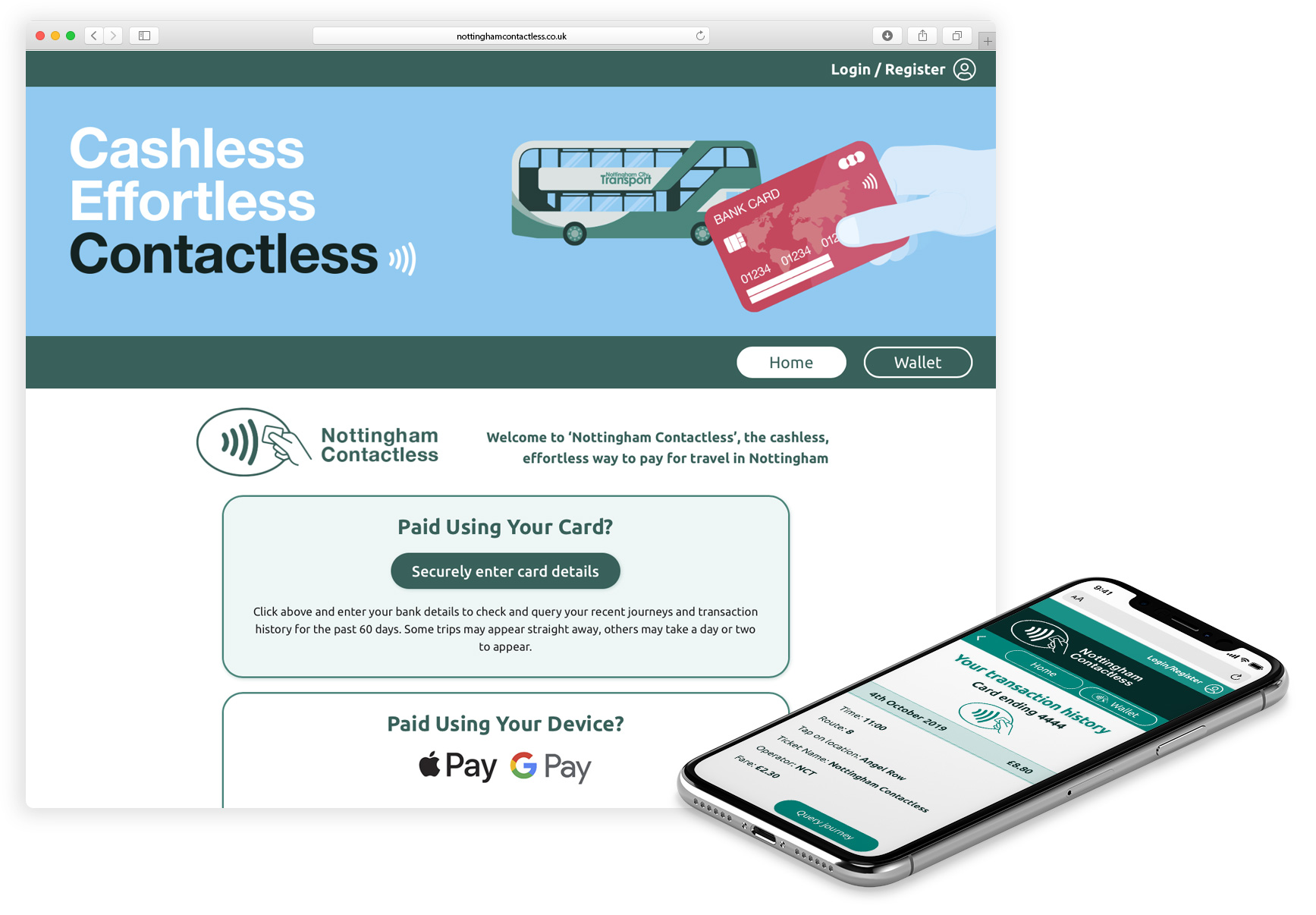
At the forefront of digital innovation for mobile ticketing
After a competitive tender process, Gooii has been awarded a new contract with Nottingham City Council to continue to deliver the website.
Gooii has a proven track record of delivering high quality applications that enhance user experience. Our previous work in Augmented Reality, Virtual Reality and web design has demonstrated our ability to push the boundaries of technology.
This project marks a significant new milestone in our ongoing collaboration with Nottingham City Council, Nottingham City Transport, NET and Linkbus services. It shows our shared commitment to driving innovation in mobile ticketing and transforming public transport with contactless technology.
We’ll also continue working with INIT (Innovations in Transportation Ltd) systems, the technology company that supplies integrated ticketing systems for buses and trains.
New features of the Nottingham Contactless website
We’ll be developing the site and supporting the project to make travelling across Nottingham easier, faster and more convenient, reducing the need for physical tickets.
We’re committed to exploring new ways to enhance Nottingham’s public transport system. As well as maintaining the site, we’ll also be developing new features. These will enhance the user experience and provide more flexibility for the fare payment process.
How the Nottingham Contactless website works
The Nottingham Contactless system was the first Oyster-style contactless ticketing system in the country outside of London.
Using the ‘Tap and Go’ capped fare feature when boarding a bus or a tram, passengers can make contactless payments with each operator and benefit from their day capping rates. This gives the best fare regardless of journey type or the number of journeys you make.
Passengers can use the Nottingham Contactless website developed by Gooii to check their recent journeys and transactions. Customers can enter their card details in order to view their travel history and a log of their payments.
Read our blog on mobile ticketing and why it’s essential for the transport sector
Accessible and secure website
It was essential for us to develop a website that is highly accessible. We ensured it was compliant to level AA with many features of level AAA compliant to Web Content Accessibility Guidelines (WCAG) and World Wide Web Consortium (W3C) guidelines.
Nottingham Contactless also has to be incredibly secure. The website integrates with a payment service provider so we also had to ensure that all transactions were Payment Card Industry (PCI) compliant. This means that no sensitive customer payment information is stored on our servers but allows for fast retrieval of journey information on subsequent visits.

Our partnership with Nottingham City Council, NCT and NET is a testament to our shared vision of a modern, efficient and accessible public transport system. We’re honoured to be playing a pivotal role in bringing this vision to life. We believe in the power of technology to transform everyday experiences. This project is the perfect example of how digital innovation can improve people’s lives.
Check out our social media feeds to keep up to date with our project: LinkedIn, X, Facebook and Instagram.
Gooii set to create Augmented Reality experiences for Cambridge’s Corn Exchange venue
We’re excited to develop innovative AR content for Connecting Cambridgeshire’s 5G Open RAN project
Gooii has been commissioned by Connecting Cambridgeshire, on behalf of Cambridgeshire County Council, to create innovative Augmented Reality (AR) content for Cambridge’s 19th century Corn Exchange venue. It will improve its visitor engagement and test out its new 5G Open RAN network.
The commission comes after Gooii secured funding from the Department for Science, Innovation and Technology (DSIT) to become a project partner for the Cambridgeshire Open RAN Ecosystem (CORE) project in October.
The content will test the newly created 5G Open RAN network, which will be in operation at Cambridge’s Corn Exchange.
Read our blog about this new network and how it will be used in High Demand Density locations.
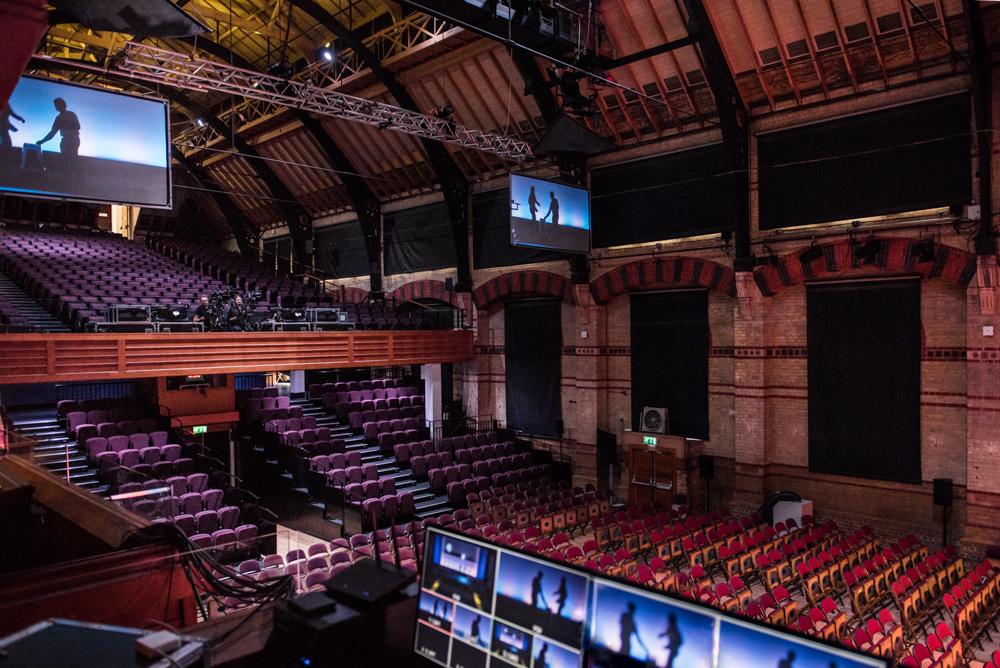
Gooii has also been commissioned to develop AR content for Cambridge’s Corn Exchange
In addition to the DSIT part-funded research and development work, Connecting Cambridgeshire requires an agency to develop ‘use case’ content for the Corn Exchange. A ‘use case’ outlines the interaction between a user and a system to achieve a specific goal. It details the steps, actions and outcomes involved. In this case, the goal is to use AR to celebrate the Corn Exchange’s 150th anniversary.
This content will run on the 5G Open RAN network and will be trialled with members of the public in 2025. After an innovative and ambitious pitch, we’re pleased to announce Gooii has been selected as the content supplier.
Using Augmented Reality to bring the Corn Exchange’s history to life
Working closely with the venue, Gooii will create a bespoke venue-specific Augmented Reality experience for the Corn Exchange and its fascinating history. It will include interactive elements and tell fascinating stories relating to its 150th year celebrations.
The AR experience, which is data intensive and has low latency requirements, will test the capabilities of the new 5G Open RAN network. It will also demonstrate how 5G Open RAN technology can support innovative technologies to generate new opportunities for a local economy.
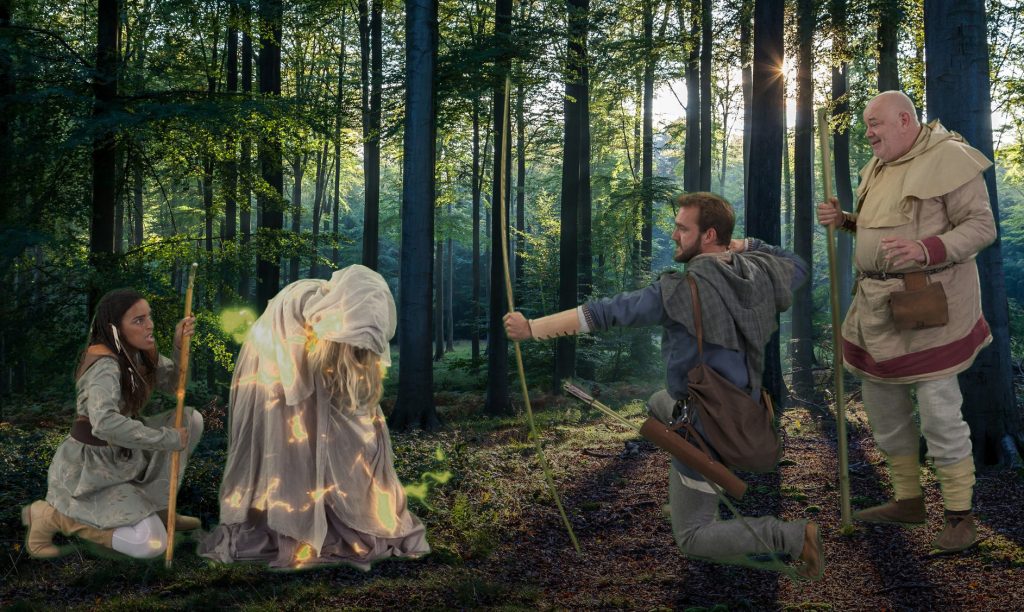
We’ll be using the technology and skills we developed to create the world’s first holographic AR ghost walk at Rufford Abbey and the ‘Robin Hood: Arrow Through Time’ holographic movie at Sherwood Forest.
Our team of talented developers is working hard to create AR and MR content with added VR elements. As part of the R&D stage, we’ve started by creating content in the development platform Unity. We’re also using in-house software developed specifically for this project. Using Unity’s scene editor, we’ll design and place virtual objects in the real world, such as innovative interactive exhibits that bring to life the history of the Corn Exchange.
We’ll then connect a variety of devices to Unity to test out the content using the Meta Quest 3 and Apple Vision Pro headsets, as well as iOS and Android devices.
Soon to be ready for public testing
When the content has been developed, we’ll organise trial sessions with members of the public. We’ll then ask Corn Exchange visitors to wear the headsets and interact with the AR content.
Based on participants’ feedback and performance testing, we’ll continuously test and refine it. We’ll optimise the AR experience for smooth performance and user interaction on all the devices. Through this, we’ll gain valuable insight into how these applications can be used. It will also allowing us to analyse the data.
Working closely with hardware partners
Our AR experience will also integrate with the project partners’ hardware and the 5G network. We’ll be working alongside the following partners:
- Connecting Cambridgeshire
- Department for Science, Innovation & Technology
- Gooii
- AWTG
- Benetel
- Ontix
- Wolfram
- University of Surrey
- University of Cambridge
We’re proud to be part of a project that strives to diversify the supply chain of the UK’s Open RAN network and are excited to see how the scheme develops. We love creating AR content for the tourism and entertainment industry and we can’t wait to test it out with members of the public.
Keep up to date with news on the project on our social media – LinkedIn, X, Facebook and Instagram.
Meet Gooii’s newest talent: Computing placement student Luka, who has a passion for VR and 3D modelling
NTU Computing student joins Gooii for third-year placement
We’re excited to introduce Gooii’s newest team member. Luka is a tech enthusiast who brings creativity, passion and a deep love for Virtual Reality (VR) to our innovative projects.
Bridging university learning with real-world experience
Luka joins us as a Junior Developer for their third-year placement as part of their Computing course at Nottingham Trent University. Having completed two years of study, Luka is gaining hands-on experience at Gooii before returning to finish the final year of the degree.
Choosing to work at Gooii was a no-brainer for our latest recruit, who has always been drawn to Nottingham’s vibrancy. Beyond its charm, Nottingham offered the perfect environment – an independent and close-knit company where creativity thrives.
“I really like Nottingham and I wanted to work at a smaller and more indie company rather than a large one. Gooii fits that perfectly, and so far it has really worked out.”
A lifelong love for coding and tech
Gooii’s expertise in VR development was another draw. The world of VR has been a long-standing passion for Luka. The opportunity to dive into this innovative field was too good to pass up.
From a young age, Luka was captivated by coding, surrounded by friends who could already speak the language of computers. This interest didn’t stop at coding, it extended to a broader fascination with computers and electronics.
Now at Gooii, those skills are being applied to a groundbreaking project: an Augmented Reality car show. Luka is currently focusing on Gooii’s 3D modelling work. They’re also developing their coding skills along the way, before they hope to start programming.
“I’m 3D modelling, texturing, rigging and making a basic Unity application. We are making an Augmented Reality car show and I am modelling many of the vehicles that will be on display in the application.”
While the university course is providing a solid foundation, much of the 3D modelling work Luka is doing at Gooii is self-taught – a testament to the power of their curiosity and drive to learn independently. In their spare time during university, Luka would model, texture and configure assets for a game called VRChat using Blender, Substance Painter and Unity. They would then sell those creations. These early projects not only brought in some extra cash but also paved the way for mastering tools that are essential in the professional realm.
An unwavering interest in Virtual Reality
If there’s one thing that truly excites Luka, it’s Virtual Reality. This passion isn’t just professional, it’s personal. Whether it’s hanging out with friends in VRChat or experimenting with the latest VR hardware, Luka is always immersed in the world of VR.
“I have been using VR for years now and have always been interested in the technology. I cannot wait to see what new hardware innovations in the VR space can drive new software experiences. I truly think it is an absolute game changer within our field.”
A love for retro tech and gaming
When not working on cutting-edge VR projects, Luka has a real interest in retro electronics and gaming. “I mess around with retro electronics. I love to collect and maintain older hardware because I find them very interesting. It’s important to keep it all working for history.”
In addition to preserving vintage tech, gaming remains a central hobby, especially playing older video games that hold a special place in their heart.
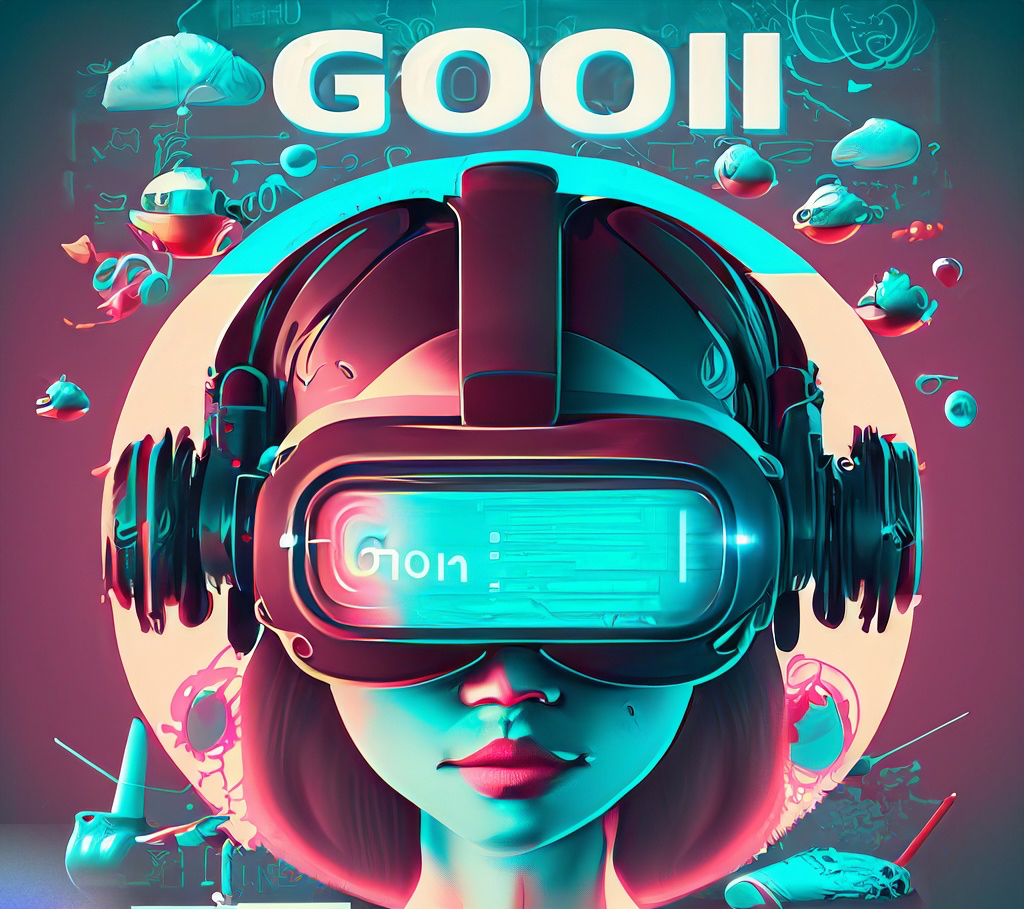
As Gooii continues to innovate in the world of VR, AR and beyond, we are excited to see our newest team member develop. Their passion for technology, creativity, and coding will really contribute to the team. With a bright future ahead, we know Luka will be a driving force behind some of our most exciting projects yet. Welcome aboard!
Fountaindale School visit: How using Augmented Reality in education can transform learning for children with Special Educational Needs
Using Augmented Reality in education offers innovative solutions for inclusive learning
Finding ways for digital technology and creativity to enhance people’s lives is one of the reasons we do what we do. We understand Augmented Reality’s power to transform learning experiences by making them more interactive and engaging, particularly when it comes to education.
Gooii Director Phil recently visited Fountaindale School in Mansfield to talk about his work as a co-founder of a digital agency. The National Careers Week initiative enabled the students to learn about the variety of professions and industries that are on offer.
Putting Augmented Reality in education into practise
Fountaindale School is a school for 3-18-year-olds who have profound and multiple learning needs, as well as complex physical, medical and sensory needs. Phil was invited by Fountaindale teacher Majella Robson to give a presentation on XR technology.
During the session Phil talked to a group of 6-16-year-olds about the Extended Reality experiences he has created at Gooii. He then gave them Hololens 2 headsets so they could try out our ‘Robin Hood: An Arrow Through Time’ holographic film.
When the user puts on the AR headset, a holographic interactive film about Robin Hood is projected into the room in front of them. This creates a reimagined, augmented reality – digital content laid over the moving landscape in front of you. This makes you feel like you are part of the movie, enabling you to interact with the film and its characters.
The teachers were blown away by how engrossed the children were with the experience. The children had previously experienced a Virtual Reality magic carpet ride, but had never tried using Augmented Reality.
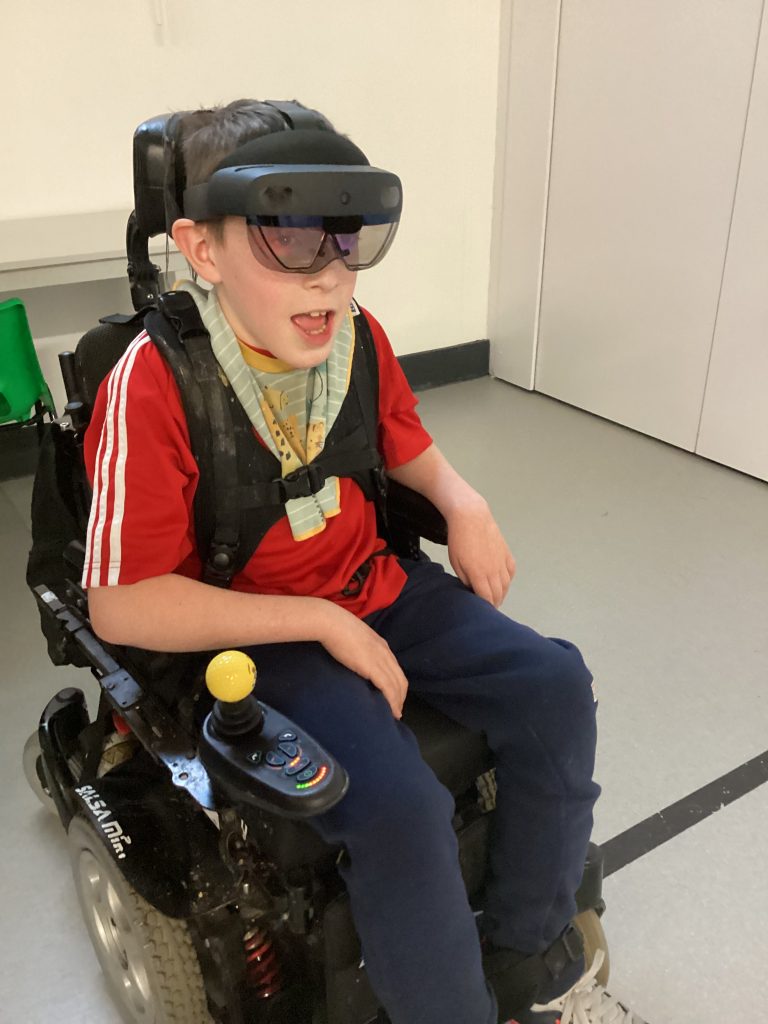
Majella at Fountaindale School said: “Phil started the session by delivering a presentation about Gooii and what they do. The pupils had the opportunity to ask questions and the presentation was interactive. Phil was engaging and he was able to link his work to things that the pupils would be familiar with. For example certain films and brands.
“This created lots of excitement and anticipation for what was to come! Phil took the time to tell each pupil what was going to happen and what to look out for when wearing the AR headset. This time was crucial and our pupils felt at ease and keen to participate as a result. It was wonderful to see our pupils so enthusiastic and immersed in the AR activities. For them to be able to interact with the scene, by holding out their hand for a bird to land on it, really was priceless.”
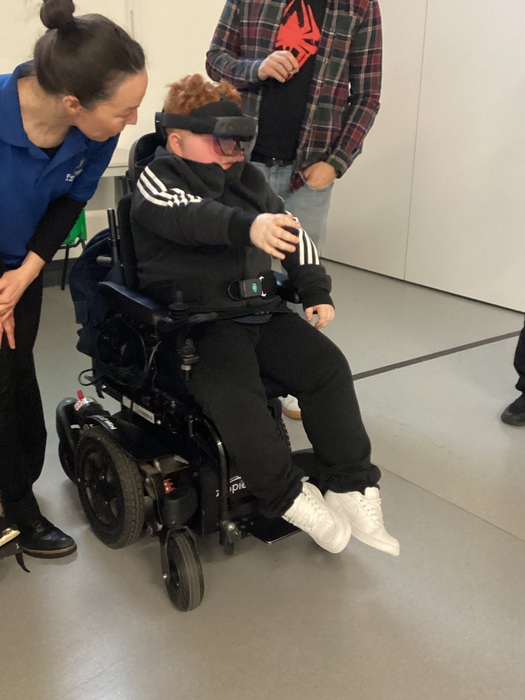
The benefits of using Extended Reality for children with SEN
AR can make learning a more fun, interactive experience. It has the ability to capture the attention of children with SEN more effectively than traditional methods. Some children with SEN struggle with understanding abstract concepts. AR can provide concrete, visual representations that can often be easier to grasp, particularly when taught step by step.
VR can often be overwhelming and almost too immersive. In contrast, AR projects digital content into the safe, familiar environment around you.
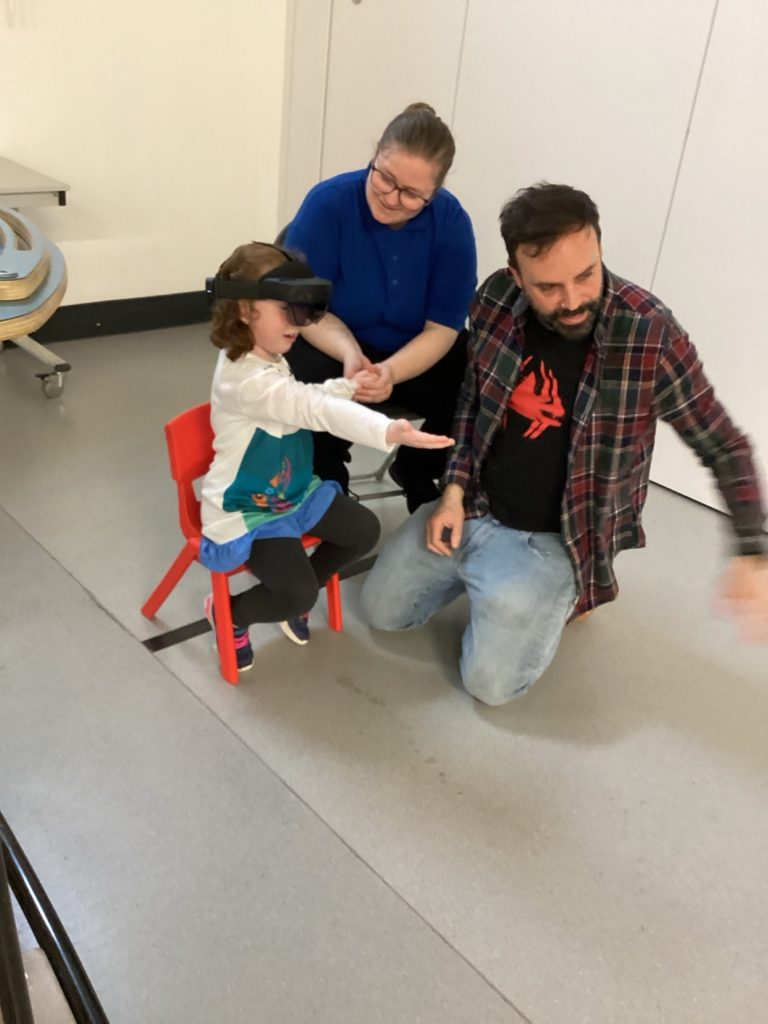
Creating a totally new, virtual space could be disorienting, particularly for children with SEN. Whereas AR enables them to remain connected to their physical surroundings while engaging with augmented content.
The ability to make AR experiences multisensory can be beneficial for children with SEN, as it could cater to preferred learning styles and needs. Using AR, we can create visual, auditory and sometimes tactile experiences that can help with information retention and engagement. These levels of stimulation can also be managed to avoid sensory overload for certain children. AR can also be an accessible learning tool for children with visual and hearing impairments. This is the headsets can be adapted to suit the user’s physical abilities.
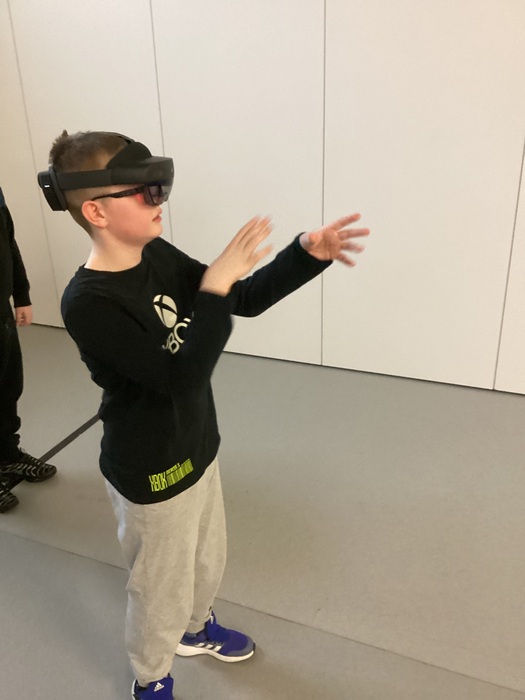
AR experiences can also encourage social interaction in a classroom setting or therapy session. As multiple children can interact with the same augmented content while still being aware of and communicating with each other.
Using AR to further improve the education of children with SEN
If we can create XR experiences that are specifically linked to the curriculum, it might enable students to engage with topics in a way that is more suited to their learning style. Imagine interacting with virtual zoos, enchanted forests and ‘visiting’ different countries. Or creating settings to inspire creative writing and storytelling, pointing and counting objects, or bursting balloons to develop counting skills. The world is your oyster when it comes to creating learning experiences with AR. Which makes it an incredibly exciting and rewarding space in which to work.
If you’d like to create an engaging learning experience using cutting-edge technology, please get in touch.
Gooii collaborates with American pharmacy association to create bespoke document management system
Document management systems are designed to enhance our clients’ productivity and efficiency
Gooii is working with the National Association of Boards of Pharmacy (NABP) in America to design a new bespoke document management system (DMS).
NABP is an international non-profit organisation whose members are the boards of pharmacy. It has a diverse range of programmes that help protect public health across America. One of its offerings is a subscription service that provides access to a database of state pharmacy laws. The resource is intended to help licensees and stakeholders maintain compliance with state requirements.
What makes an effective document management system?
An efficient DMS is essential for organisations aiming to streamline their document handling and improve accessibility. Creating a bespoke system enables our clients to focus on managing documents for their subscribers and allowing them to search within their database. A good DMS needs to have an intuitive user interface, robust search functionality, efficient document indexing and effective integration capabilities. They also need to have regular, built-in data backups and a robust disaster recovery plan.
Why NABP approached Gooii to develop a bespoke DMS
Gooii is well versed in handling large data sets and helping our clients present them in a clear, concise way. We develop streamlined, intuitive User Interfaces (UI) that can be understood by both researchers and laymen. They also enable users to quickly search for specific terms and documents.
NABP’s existing document management system lacked certain functionalities, which required manual, time-consuming processes.
Having seen our software development first hand with the Archives Hub system we developed for Jisc, NABP got in touch to discuss the possibilities of Gooii developing a system with similar functionality. They particularly liked the hierarchy viewer on the right hand side of the Archives Hub system, because of how easy it is to use and navigate. It helps users to visualise the hierarchical nature of the data.

Read about our work for Jisc’s Archives Hub
The brief
NABP asked our team of developers to build a bespoke document management system that will enable them to effectively manage and organise the thousands of legal documents in their database and for users to easily find the information they need.
We are building both the internal and front-end systems for its 90 single and multi-user subscribers. This will allow users to search and download documents, organise them into collections and share them as links.
NABP also needs to ensure that when an administrator uploads a new document, the contents of the document are indexed and downloadable PDF versions are created.
How we’re going to create the new document management system
Using a CIIM to index documents
Gooii is working with Knowledge Integration and their Collections Information Integration Middleware (CIIM).
CIIM is a middleware solution – software that works between an operating system and the applications running on it. The CIIM can extract, collect and synchronise data from back-office systems and present it to users in the super quick Elasticsearch database. We used CIIM and Elasticsearch for Jisc’s Archives Hub and knew it would work perfectly for NABP. This is due to its ability to index documents and publish them to Elasticsearch, as well as its capability to create PDF versions of uploaded documents.
Working with our clients’ cloud technology
NABP uses Amazon Web Services (AWS) cloud technology, so we’re developing the project using different AWS elements, such as Amazon Cognito. Amazon Cognito is an identity platform for web and mobile apps. It will help us add user authentication to NABP’s system. Amazon Cognito enables you to authenticate and authorise users from the built-in user directory, your own organisation’s directory or consumer identity providers like Google and Facebook. Developing these access control functions and other essential security features are crucial for document security.
We’re also using Amazon Lambda. When a new document is uploaded, or an amendment is made to a document, a Lambda function will be triggered and will tell the CIIM, causing it to re-index the new document’s contents.
Gooii is also working closely with NABP using the following pieces of software:
- Re-frame to help manage UI state and side effects on the client side.
- ClojureScript to transcode Clojurescript into javascript.
- User interface builder REACT 18 to build reusable UI components,
- We’re using the Tailwind css framework with shadcn/ui library to build the front-end website.
- Amazon’s DynamoDB database to develop user-generated content such as collections of documents.
NABP is currently developing Application Programming Interfaces (APIs) that we’ll be able to integrate with the front-end website and back-office system. While this is being worked on, our team of developers are working hard on the admin dashboard and functionality to upload documents to an AWS cloud storage platform. We’re also working on making the search function available to subscribers, as well as an admin user interface that enables files and folders to be manipulated.
We’re proud to be part of a project that makes data more accessible and we’re excited to create a new bespoke system that will improve the way our client documents its data.
DMS play a vital role in modernising document-related processes and enhancing the efficiency of a business. They are especially crucial in industries and sectors where document-intensive workflows are prevalent. If you’d like to discuss Gooii creating a DMS for your business, please get in touch.
Keep up to date with news on the project on our social media – LinkedIn, X, Facebook and Instagram.
Article by
Franz Evert
Franz is a Technical Director at Gooii and has over 20 years’ experience developing commercial and open source database driven software in many languages. Franz’s other skills include project management and client liaison and he’s passionate about high web standards and internet security.

